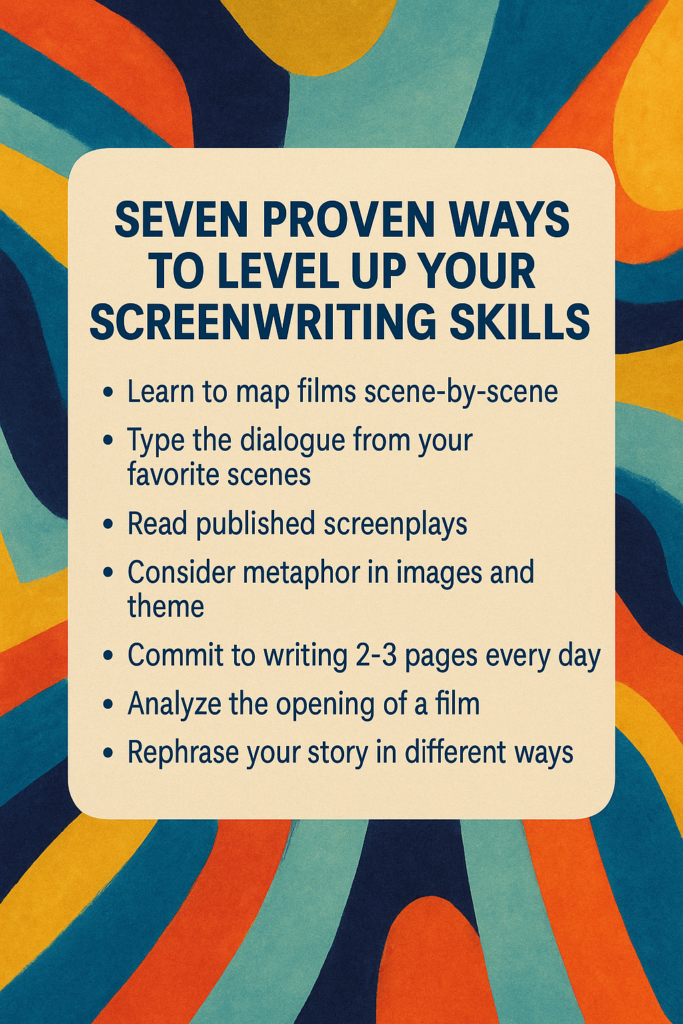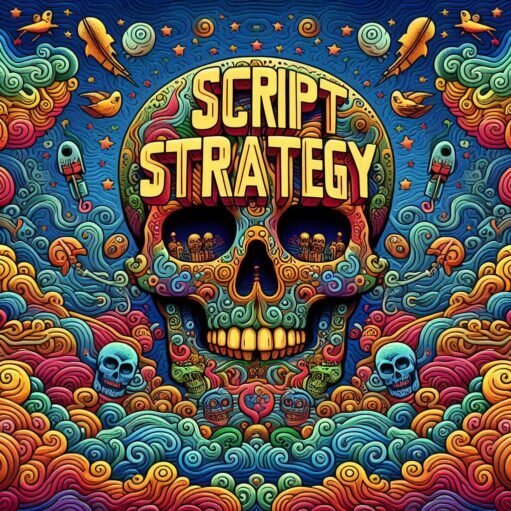7 Proven Ways to Level Up Your Screenwriting Skills

The craft of screenwriting is a lifelong education. Mastering it doesn’t happen overnight—it happens page by page, scene by scene, and draft by draft.
Screenwriting is storytelling in architecture. Your screenplay is a blueprint–it’s not a completed work–yet this blueprint must evoke emotion, reveal character, advance plot, and create cinematic rhythm, all while staying lean and visual.
Fortunately, there are concrete ways to build these skills.
Let’s look at seven deeply practical, highly effective ways to improve your screenwriting skills, and why each of them works. Even if you only integrate one of these into your creative endeavors, you’ll start seeing sharper scenes, tighter structure, and develop a clearer voice.
1. Map Your Favorite Films Scene by Scene
One of the most powerful learning tools to develop your screenwriting skills requires only your time and focus.
Pick one of your favorite films—especially one that’s praised for its screenplay—and break it down scene by scene. Create a document where you list every single scene in order, starting from the first moment of the film.
For each scene, note down:
- Where it takes place (INT. or EXT., location, time of day)
- The characters involved
- What happens (literally, and emotionally) – the “literally” part means focus specifically on the action, taking interpretation away; this is easier said than done
- Note how this scene moves the story forward
- What changes between the beginning and end of the scene
This exercise is far more than just academic. Not least, when you read enough academic Film Studies papers and books, you realize that a fair chunk of these academics couldn’t map a screenplay if they tried.
Rather, you’re training your brain to see how the rhythm of a story works. You begin to see the skeleton beneath the skin: it becomes more obvious how a story escalates, when turning points hit, how acts are structured, how exposition comes out of drama (and not vice-versa), and how subplots interweave.
Better still, this exercise internalizes scene function. You’ll notice that good movies don’t have filler—they have scenes that each do at least one job, often two or three.
Try this with everything from The Godfather to Get Out to The Social Network. Do the same with your own script. Compare. Adjust. Improve.
2. Type Out Dialogue
This method to improve your screenwriting skills sounds bizarrely simple: physically type out dialogue from a scene you love.
Not just read it—type it. Muscle memory matters.
Find a scene that hits hard: maybe Jack’s courtroom showdown in A Few Good Men, or the “I coulda been a contender” moment in On the Waterfront.
Notice:
- The rhythm of the exchanges
- The pacing and economy of lines
- Use of subtext
- How information is revealed
- How silence or interruptions are used
This practice lets you feel the texture of professional dialogue. You’ll see how good writers avoid on-the-nose writing, suggest more than they say, and build character from how something is said, not what is said.
This method encourages learning formatting, structure, and spacing subconsciously. Typing out screenplays imprints the correct flow into your process.
3. Read Published Screenplays—The Good and the Bad
Reading screenplays is essential. Read ones that are produced and respected, especially those nominated for screenwriting Oscars, or hosted in the WGA or Academy’s script library.
When you read great scripts (Fargo, Eternal Sunshine of the Spotless Mind, Moonlight, Lady Bird, etc.), you see:
- How tone is established on the page
- How description can be lean yet evocative
- How formatting supports clarity
- How each scene either escalates conflict or reveals character
But–and of course only when you’re feeling a bit more comfortable about what makes a good script–read bad scripts, too. There are plenty online—scripts that were rejected, films that flopped, or early drafts of better-known works.
When you read bad scripts, you become a better editor. You start to see what not to do—flat dialogue, overwriting, scenes that go nowhere. This critical eye is key for revising your own work.
Reading screenplays trains your mind to think in cinematic language. This avoids the “would-be novel” trap that early screenwriters often face.
4. Metaphor in Images and Theme
At the heart of every great film is a cohesive thematic core, and the best writers know how to reinforce that theme not just through plot or dialogue, but through visual metaphor.
Take Jaws. Yes, it’s about a shark—but it’s also about fear, impotence, and civic denial. The shark becomes more than a fish; it’s a metaphor for a society unwilling to confront danger.
Or look at Parasite. The stairs, the smell, the flood—all visual motifs that reinforce class stratification. Every image is working on two levels: surface function and symbolic meaning.
Ask yourself:
- What is my story really about?
- What metaphors support that theme?
- How can my locations, objects, and recurring visuals echo that deeper meaning?
This adds depth and resonance to your script. It elevates a functional story into something that lingers in the viewer’s mind. And it shows directors and readers that you understand how cinema builds on story but is something more.
5. Commit to Writing 2–3 Pages Every Day
Consistency beats inspiration.
You don’t need to write a full act in one sitting. But if you write 2 to 3 pages a day, you’ll have a feature-length first draft in just over a month.
This daily habit does all of the following:
- Keeps the story fresh in your mind
- Builds your creative stamina
- Forces you to make decisions
- Trains you to write through imperfection
Some days the pages will be amazing. Other days they’ll be total garbage. It doesn’t matter. Screenwriting is rewriting. But remember, you gotta have something on paper if you’re going to revise it.
If consistency is a struggle, turn your writing time into a ritual: same time, same playlist, same 30 minutes. Set a timer. Get to work. It’s like exercising for health: you’re not trying to break a record; you just need to show up.
6. Watch Movies with the Subtitles On—And Sound Off
Try this weird trick–not spammy, I promise!–to see the screenplay in action.
Watch films with the subtitles on, but the sound off. Why? Because it forces you to:
- Focus on pacing
- Notice dialogue rhythm without performance
- Pay attention to visual storytelling
- Notice the time and place at which information is revealed
You’ll start to the level to which an actor brings dialogue to life, and how much the camera does on its own. You will also soon notice–particularly in bad movies–which lines are redundant. That is, these lines don’t need to be spoken because the images makes them clear.
Use this method to refine your decision-making about when to write and when to let the image do the work. Screenwriting is a visual medium. Show, don’t tell. Yes?
7. Workshop Your Script in Table Reads
Writing is a solitary act. But screenplays are meant to be spoken.
If you haven’t done this yet, gather a group of friends—actors, writers, or just film lovers—and host a table read of your script. Assign parts, sit around a table (or Zoom), and read the entire thing out loud.
The outcome might be surprising:
- “That joke didn’t land.”
- “That scene feels much too long.”
- “That line sounded good on paper but fell flat when spoken.”
This trains auditory awareness. Dialogue must flow. Scenes must bounce. If it doesn’t work–even with no actors’ juice behind it–then it probably isn’t working.
If you record the session, even better: you can play it back later and make further notes.
Also–and it ought to go without saying, but in case it doesn’t. Don’t be defensive–keep your mouth shut during the read and let the readers do their job. Your job is to hear the film, not defend something that may not be–and by that I mean probably isn’t!–working.
Screenwriting Is Built, Not Born
Every great screenwriter once wrote their first page. Every great script was once a messy first draft. Every polished scene wasn’t, well, polished. These things don’t just fall out of the sky.
Daily effort, analytical watching, deliberate reading, critical listening, and courageous rewriting all separate dreamers from doers.
The more you map films, the better your structure becomes.
The more you type great dialogue, the sharper your ear grows.
The more you write, the closer you get to mastery.
And the more you understand visual metaphor and cinematic rhythm, the more your pages breathe with true screen potential.
You don’t have to get it right—you just have to keep going.
So: start your scene breakdown. Open that script PDF. Type the monologue. Write your two pages. And tomorrow, do it again.

